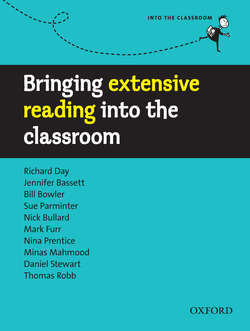Читать книгу Bringing extensive reading into the classroom - Richard Day - Страница 4
На сайте Литреса книга снята с продажи.
Part 1
Extensive Reading: the theory
Оглавление 1 Extensive Reading: the background
Richard Day
WHAT IS EXTENSIVE READING?
Extensive Reading (ER) in the EFL/ESL context is an approach to teaching reading whose goal is to get students reading in the English language and enjoying it. ER is based on the well-established principle that we learn to read by reading. This is true for learning to read our first language as well as foreign languages. In teaching foreign language reading, an ER approach allows students to read, read, and read.
In ER, students read large quantities of easy material (usually books) in English. They read for overall meaning, for information, and for pleasure and enjoyment. Students select their own books, and are encouraged to stop reading if a book is not interesting to them or is too hard; they are also encouraged to expand their reading comfort zone (the range of materials that students can read easily and with confidence).
In Extensive Reading Activities for Teaching Language, Bamford and Day maintain that an ER approach consists of ten principles. Let us look at the first four:
1 The reading material is easy.
For ER to be possible and for it to have the desired results, learners must read books and other materials that are well within their reading comfort zone. When students do this, they are able to read for overall meaning easily and they don’t have to worry about a lot of difficult or unknown words. In helping beginning readers to select what to read, I believe that more than one or two unknown words per page might make the text too difficult for overall understanding for beginning readers. For intermediate learners, appropriate reading material has no more than three or four unknown or difficult words per page. In their article ‘Unknown vocabulary density and reading comprehension’ in Reading in a Foreign Language, Hu and Nation (2000) suggest that learners need to know at least 98 per cent of the words in a book of fiction to be able to read without using their dictionaries.
I recognize that not everyone agrees with using easy materials. Some teachers believe that learners must read difficult texts; they also believe that students need to be challenged when learning to read. Perhaps they think that reading difficult texts helps prepare their students to read materials written for first-language (L1) reading.
I believe this confuses the means with the end. Clearly our ultimate goal in teaching students to read is to have them read material written for native readers. But we should not start with that goal! We need to start with books and materials that have been especially written for beginning and intermediate levels of reading ability. Learners have to read texts that they find easy and enjoyable as they learn to read, or they will simply not read at all.
